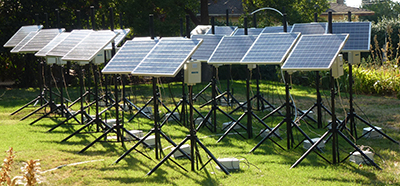Using Low-Cost Sensors to Evaluate the Spatial Variability of Ozone
Clients
San Joaquin Valley Unified Air Pollution Control District (SJVUAPCD)
Highly variable ozone concentrations at closely located monitoring sites prompted the San Joaquin Valley Unified Air Pollution Control District (the District) to conduct a special study to assess the relocation of a regulatory monitor in Arvin, CA. The District ran monitors at the original and replacement sites in parallel for about one year. Analyses showed that ozone measurements at the new site 2 miles away were about 10% lower than measurements at the old site. The concentration difference prompted the District to sponsor a field study to determine ozone gradients in and around that site.
<br>
We deployed 23 ozone sensor systems to sites in and around Arvin during summer 2013. We collocated the ozone sensors with a federal equivalent method (FEM) instrument for inter-comparison and calibration before and after the 6-week field program. The results of this study demonstrated the
<ul>
<li>Spatial variability of ozone in the area</li>
<li>Usefulness of lower-cost sensors for this type of deployment</li>
<li>Importance of careful study design to ensure high quality data when using sensors</li>
<br>
We deployed 23 ozone sensor systems to sites in and around Arvin during summer 2013. We collocated the ozone sensors with a federal equivalent method (FEM) instrument for inter-comparison and calibration before and after the 6-week field program. The results of this study demonstrated the
<ul>
<li>Spatial variability of ozone in the area</li>
<li>Usefulness of lower-cost sensors for this type of deployment</li>
<li>Importance of careful study design to ensure high quality data when using sensors</li>
Air Quality
Data Management
Environmental Justice
Low-Cost Sensors
Measurements


Clinton P. MacDonald

Clinton
P.
MacDonald
President / Chief Scientist
Clint@sonomatech.com
/sites/default/files/2023-02/CPMres.pdf
